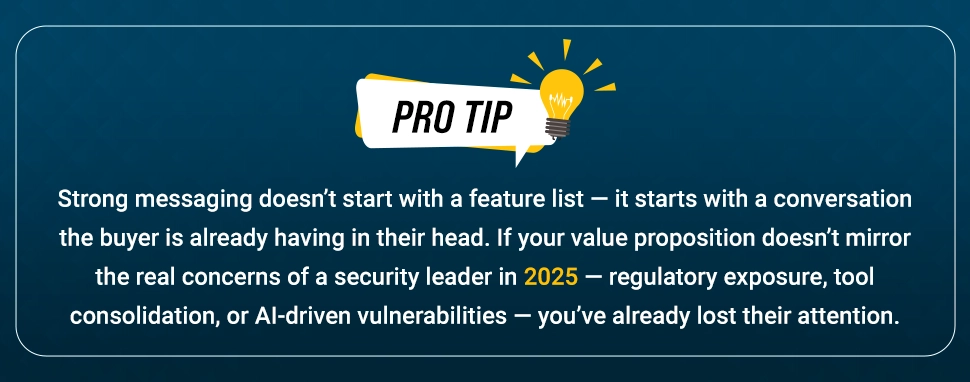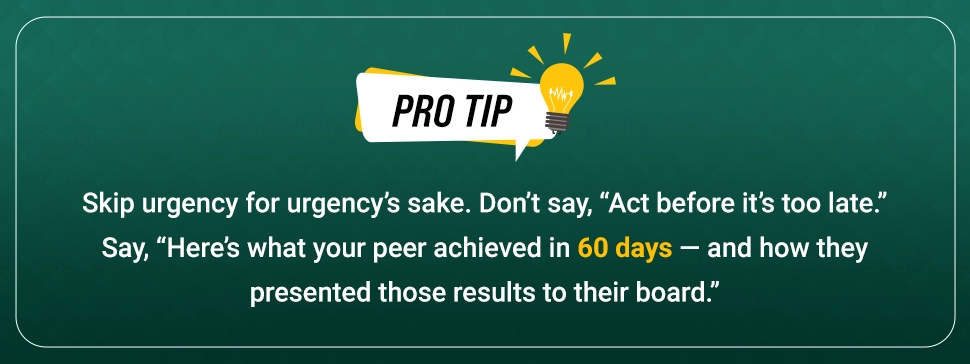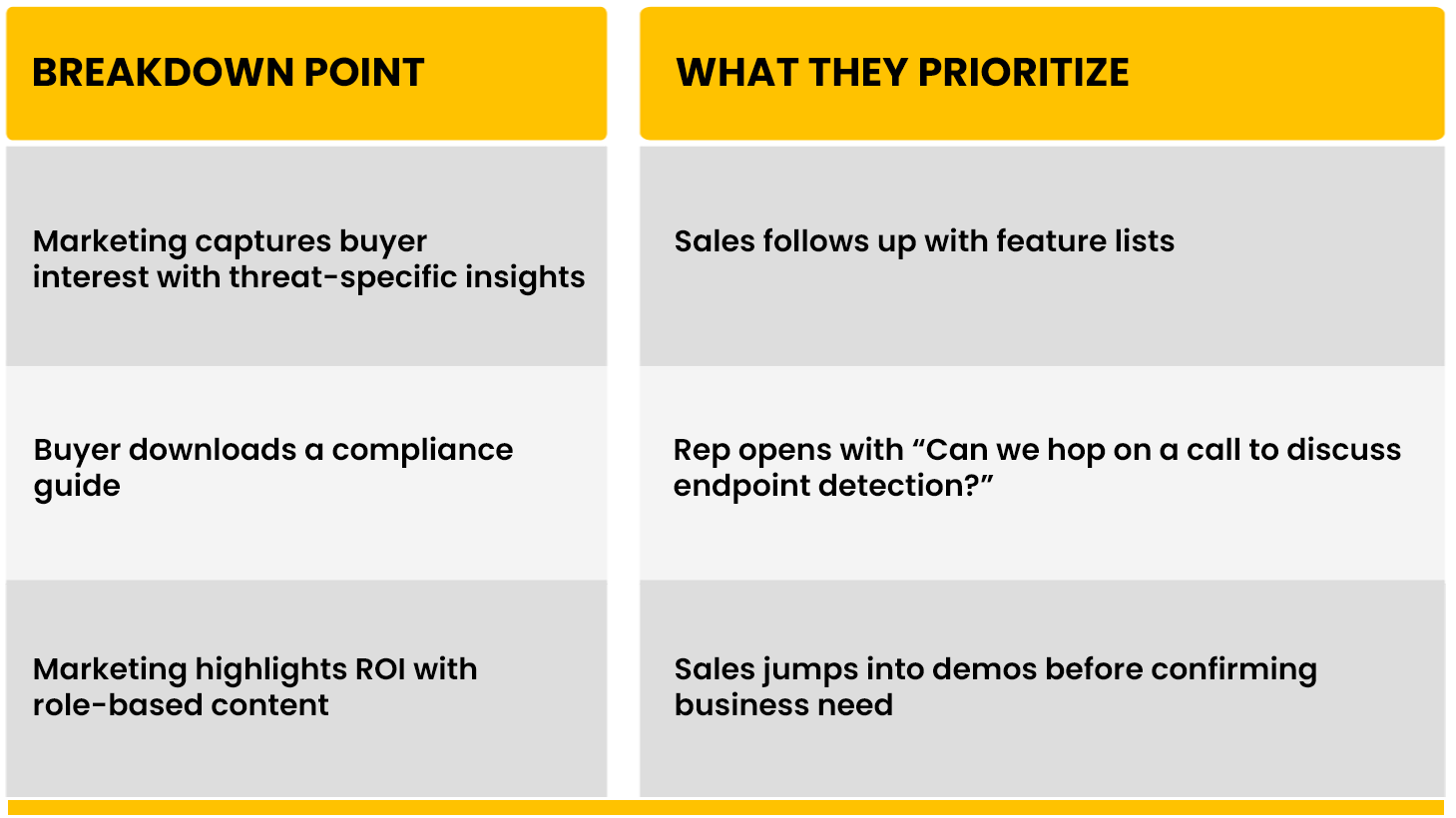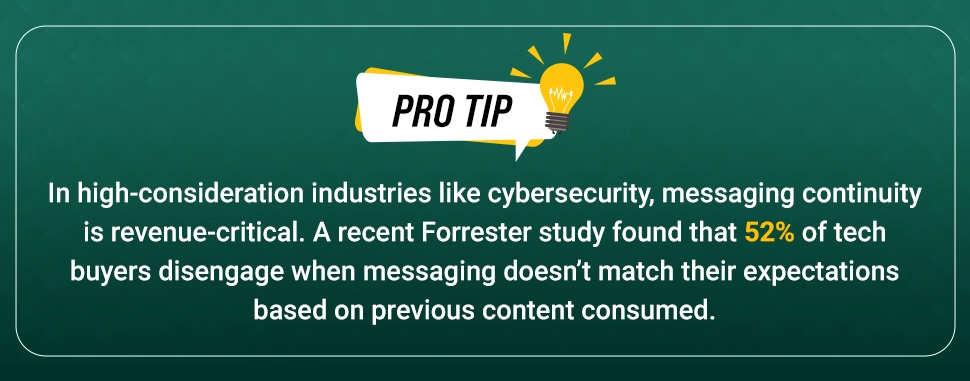In 2025, cybersecurity messaging is under more pressure than ever — not just to inform, but to convert.
With 72% of cybersecurity purchase decisions now involving non-technical stakeholders like CFOs, compliance heads, and enterprise architects (Forrester, 2024), vague claims and one-size-fits-all copy no longer cut through. Yet many cybersecurity vendors still lead with generic language - "next-gen threat defense," "AI-powered protection," "proactive risk reduction" - without showing real business relevance.
The result? Good leads stall. Sales momentum dies. And it's not because the solution lacks merit - it's because the messaging missed the mark.
Today, the real competition isn't just between products. It's between how clearly each vendor communicates impact. When your outreach fails to speak to tool consolidation, audit readiness, or board-level reporting, you've already lost the room.
In this blog, we explore why most cybersecurity messaging fails in 2025 - and how sales enablement can become the difference between a lost opportunity and a booked meeting.
The Messaging Disconnect: Why Smart Leads Go Cold
Let's face it - a large chunk of cybersecurity messaging today lacks specificity, urgency, and business alignment. Generic pitches like "Eliminate risk with next-gen threat intelligence" sound more like recycled ad copy than a credible value proposition. These lines don't engage, they alienate.
In 2025, the modern CISO and the wider security decision-making unit expect messaging that does three things:
- Reflects a real grasp of their threat environment - not just surface-level terminology
- Speaks to business outcomes like regulatory readiness, cost efficiency, and audit alignment
- Strikes the right tone - technically competent but boardroom relevant
Yet most outreach still reads like a whitepaper from 2018: bloated with fancy words, stripped of urgency, and lacking in situational relevance. According to a 2024 Demand Gen Report, 64% of B2B tech buyers have walked away from vendors because their messaging felt irrelevant or impersonal. In cybersecurity - where credibility is critical - that gap is not just inefficient, it's expensive.

1. Messaging That Misses the Moment
A growing challenge currently isn't lack of security investment - it's lack of message-market fit.
In 2025, cybersecurity buyers are navigating dynamic threats - LLM-based phishing, insider misconfigurations, cloud compliance updates - all while juggling lean teams and intense board pressure. But vendor messaging still defaults to templates and timeworn taglines.
Here's what poor messaging typically sounds like:
- "Our next-gen firewall detects threats faster."
- "Be proactive in your defense."
- "Avoid costly breaches with us."
These aren't just ineffective. They're lazy - especially when buyers are expecting use-case fluency, not platitudes.
What impactful messaging looks like instead:
Timely hooks: "In Q1, phishing attacks targeting CFOs spiked 73%. Here's how our clients adjusted in real time."
Outcome framing: "We helped a SaaS company reduce false positives by 45% with ML-powered alert tuning - during a compliance audit window."
Contextual empathy: "We know your team's overburdened. This playbook shows how a 5-member SecOps team automated incident response across 3 regions - without new headcount."

Great messaging doesn't just address a pain - it time-stamps it, quantifies it, and positions your solution as the most logical next move.
2. The CISO Is Not the Only Buyer
In 2025, the buying center for cybersecurity has officially expanded - and matured. It's no longer about selling "to" the CISO. It's about aligning with a matrix of stakeholders, each assessing your value through a different lens.
Here's how priorities vary by persona:
This cross-functional dynamic means your messaging needs to flex across functions - not just channels. And "personalized" can't just mean a first name in a subject line.
Here' how high-performing sales teams address this:
- Use persona-specific sales playbooks that speak each stakeholder's language
- Equip reps with modular sales content - e.g., board-friendly compliance scorecards, ROI simulations, and architecture diagrams
- Build coordinated ABM tracks that align messaging across the funnel by role
To explore how ABM and multi-stakeholder engagement strategies are reshaping cybersecurity sales, explore our latest blog on why cybersecurity leaders need ABX and ABM to close high-value deals. (Check out the blog here.)

3. Where Messaging Breaks Down: Sales & Marketing Misalignment
In cybersecurity, a lead can go from "high intent" to "lost cause" in just one email - and often, it's not the product that's at fault. It's the misalignment in messaging between marketing and sales.
At the top of the funnel, marketing teams spend months creating content that educates CISOs, tracks buyer intent, and builds credibility. But when the handoff to sales happens, that nuanced journey often vanishes.
Sales reps, unaware of the lead's content path, fall back on generic product decks. The result? A sudden drop in relevance - and an equally sudden exit by the buyer.
Here's what misalignment usually looks like:

The fix? Equip reps with contextual visibility - what was read, what pain points were signaled, what content drove the lead. A CRM isn't just a lead log; it's the script for personalized engagement.
4. Buyers Aren’t Looking for Products — They’re Looking for Partners
Security leaders today aren't browsing for another shiny tool. They're dealing with escalating threat landscapes, budget scrutiny, and the pressure to deliver measurable outcomes to the board.
What they're seeking is consultative support - vendors who can help them move the needle on what actually matters:
• Proving ROI and risk reduction in board-level conversations
• Addressing exposure from recent breaches or audit flags
• Reducing alert fatigue and burnout in lean security teams
• Rationalizing overlapping toolsets for cost efficiency
Yet, most outbound messaging still reads like a spec sheet or feature dump. It's not just tone-deaf - it's a wasted opportunity.
What consultative messaging looks like in practice:
"We helped an enterprise CISO reduce redundant licenses across four tools - saving 21% of their security stack spend."
"Our ingestion workflows helped two BFSI clients accelerate PCI-DSS compliance reporting by 2 weeks."
These aren't just product benefits. They're boardroom talking points.
5. Sales Enablement Is the New Messaging Engine
Sales enablement has evolved - it's no longer a back-office function for slides and spec sheets. In cybersecurity, it's the engine that ensures every touchpoint between rep and buyer is credible, contextual, and conversion-worthy. The best GTM teams are treating sales enablement as a strategic messaging layer - not an afterthought. Here's what that looks like when done right:
- Persona-based talk tracks designed for real-world objections - e.g., how to handle a compliance officer who wants GDPR assurances vs. a CIO focused on cloud latency.
- Real-time CRM enrichment that shows reps what each lead has engaged with, and what pain points they're most likely to care about.
• Use-case storytelling frameworks baked into the sales journey - not just "why our platform is great," but "how we helped a peer organization cut breach detection time in half."
And the end result? Sales teams that don't just talk about the product - they sell relevance.
Final Thoughts: In Cybersecurity, Messaging Is the Conversion Engine
In 2025, cybersecurity messaging isn't just part of your GTM stack - it's the difference between interest and inertia.
Today's buyers aren't asking "What does your platform do?" - they're asking "How does this help me justify budget, consolidate tools, or pass my next audit?"
That's where sales enablement shifts from support to strategy.
The most effective cybersecurity vendors aren't just refining product demos - they're embedding message-market fit across every touchpoint. From SDR outreach to late-stage board decks, every interaction is calibrated for business relevance, stakeholder context, and buyer readiness.
At Denave, we help cybersecurity brands operationalize this shift. Through tailored sales enablement programs - persona-specific messaging kits, CRM-integrated lead intelligence, and consultative talk tracks - we build messaging systems that drive credibility, compress sales cycles, and convert qualified interest into action.
Because in cybersecurity, it's not enough to be secure. You have to sound like the solution your buyers already believe in.
Ready to turn your messaging into a true sales advantage? Let's talk.
FAQs:
1. What is cybersecurity messaging, and why is it crucial in 2025?
Cybersecurity messaging is how vendors communicate solution value. In 2025, it must reflect business impact, not just technical features - especially with CFOs and compliance officers joining the buying process.
2. How does sales enablement enhance cybersecurity messaging?
Sales enablement empowers reps with persona-specific content and insights, helping them deliver relevant, high-impact messaging that aligns with stakeholder priorities and shortens sales cycles.
3. What are common pitfalls in cybersecurity messaging for enterprise buyers?
Generic language, feature-heavy pitches, and lack of stakeholder alignment are common issues. These miss the mark for buyers looking for outcomes like audit-readiness or ROI clarity.
4. Why is personalized messaging important in cybersecurity sales?
Enterprise buyers want messaging that speaks to their specific concerns - from compliance to integration. Personalization builds trust and drives better engagement across the funnel.
5. How can organizations improve their cybersecurity messaging strategy?
Focus on buyer personas, align sales and marketing, and update messaging to reflect current threats and regulations. Consistency and clarity are key to winning trust and deals.
Read Responses
No Comments
Leave a Reply
Your email address will not be published.

